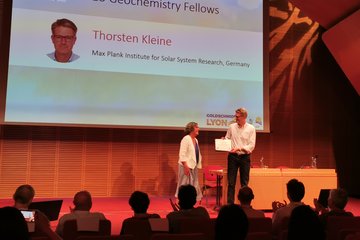Alle Typen
321.
Vortrag
The CASSINI Grand Finale in Saturn's Magnetosphere 2016-2017 in the View of Neutral And Charged Particles Measured by the MIMI Instrument. Conference on the Magnetosphere of the Outer Planets , Sendai, Japan (2019)
322.
Vortrag
Origin and Triggers of the 1-hour Electron Pulsations in the Saturnian System. Conference on the Magnetosphere of the Outer Planets , Sendai, Japan (2019)
323.
Vortrag
Plasma Heating at Jupiter and Saturn. Conference on the Magnetosphere of the Outer Planets , Sendai, Japan (2019)
324.
Vortrag
A Local-Time Confined Electron Radiation Belt Generated by Saturn's F-Ring. Conference on the Magnetosphere of the Outer Planets , Sendai, Japan (2019)
325.
Vortrag
Relativistic charged particles, neutrons and gamma rays at Saturn: MIMI/LEMMS measurements and GEANT4 simulations. Conference on the Magnetosphere of the Outer Planets , Sendai, Japan (2019)
326.
Vortrag
Spectral signatures of corotation drift resonant acceleration in Saturn's electron radiation belts. Conference on the Magnetosphere of the Outer Planets , Sendai, Japan (2019)
327.
Vortrag
Die Mission CASSINI/HUYGENS zum Saturn - Enthüllungen und Geheimnisse, Überraschungen und offene Fragen. IAS Mitgliederversammlung, Bad Soden-Salmünster, Germany (2018)
328.
Vortrag
The MSA Instrument (Mass Spectrum Analyzer) Onboard Bepi Colombo MMO (Mercury Magnetospheric Orbiter). Mercury: Current and Future Science of the Innermost Planet, Columbia, Maryland, USA (2018)
329.
Vortrag
Ring- and Moon-Associated Energetic Particle dropouts observed by MIMI-LEMMS during Cassini's Ring-Grazing Orbits. COSPAR 2018 - 42nd Assembly, Pasadena, CA, USA (2018)
330.
Vortrag
Global Flows Of Energetic Ions In Jupiter's Equatorial Plane During The Galileo Era 1995-2003. European Planetary Science Congress 2018, Berlin, Germany (2018)
331.
Vortrag
JUICE: A European Mission to Jupiter and its Icy Moons. COSPAR 2018 - 42nd Assembly, Pasadena, CA, USA (2018)
332.
Vortrag
Planetary Exploration, Horizon 2061: Some proposed next steps for giant planets systems exploration. Cassini Science Symposium, Boulder, CO, USA (2018)
333.
Vortrag
Global maps of energetic charged particles at Saturn and their relation to the magnetic field. Cassini Science Symposium, Boulder, CO, USA (2018)
334.
Vortrag
New insights into Saturn’s inner magnetosphere during Cassini’s Grand Finale: MIMI. Cassini Science Symposium, Boulder, CO, USA (2018)
335.
Vortrag
Planetary period modulations of reconnection events in Saturn’s magnetotail. Magnetospheres of the Outer Planets Conference , Boulder, Colorado, USA (2018)
336.
Vortrag
Signatures of Europa’s atmosphere in Galileo EPD data during the E12 flyby. Magnetospheres of the Outer Planets Conference , Boulder, Colorado, USA (2018)
337.
Vortrag
The ion radiation belts of Jupiter and Saturn. Magnetospheres of the Outer Planets Conference , Boulder, Colorado, USA (2018)
338.
Vortrag
Synergistic Magnetospheric Science with Europa Clipper and Juice. Juice/Europa Clipper workshop, Caltech, Pasadena (2018)
339.
Vortrag
Future Jovian Magnetospheric science with JUICE. Magnetospheres of the Outer Planets Conference , Boulder, Colorado, USA (2018)
340.
Vortrag
Auroral storm and polar arcs at Saturn – Final Cassini/UVIS auroral observations. Magnetospheres of the Outer Planets Conference , Boulder, Colorado, USA (2018)











